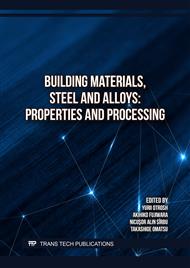[1]
M.V. Sezhian et.al., Comparative study of friction stir welding process and its variables, Materialstoday Proceedings, 2020, Vol. 33, 7, pp.4842-4847.
DOI: 10.1016/j.matpr.2020.08.394
Google Scholar
[2]
D. Abrosio et. al, Plastic behavior-dependent weldability of heat-treatable aluminium alloys in friction stir welding, The International Journal of Advanced Manufacturing Technology, 2021, Vol. 117, pp.635-652.
DOI: 10.1007/s00170-021-07754-4
Google Scholar
[3]
O. S. Salih, H. Ou, W. Sun, Heat generation, plastic deformation and residual stresses in friction stir welding of aluminium alloy. International Journal of Mechanical Sciences, 2023, Vol 238.
DOI: 10.1016/j.ijmecsci.2022.107827
Google Scholar
[4]
H. Jia, K.Wu, Y.Sun, Numerical and experimental study on the thermal process, material flow and welding defects during high-speed friction stir welding. Materialstoday Communications, 2022. Vol. 31.
DOI: 10.1016/j.mtcomm.2022.103526
Google Scholar
[5]
M. Akbari, P. Asadi and T. Sadowski, A Review on Friction Stir Welding/Processing: Numerical Modeling. Materials, 2023, 16(17), 5890.
DOI: 10.3390/ma16175890
Google Scholar
[6]
A. Laska and M. Szkodo, Manufacturing Parameters, Materials, and Welds Properties of Butt Friction Stir Welded Joints-Overview, Materials, 2020, 13(21), 4940.
DOI: 10.3390/ma13214940
Google Scholar
[7]
M Boukra, et al., Friction stir welding process improvement through coupling an optimization procedure and three-dimensional transient heat transfer numerical analysis. Journal of Manufacturing Processes, 2018, Vol.34, part A, p.pp.566-578.
DOI: 10.1016/j.jmapro.2018.07.002
Google Scholar
[8]
R. Jain, S.K. Pal and S.B. Singh, Numerical modeling methodologies for friction stir welding process, Woodhead Publishing Reviews: Mechanical Engineering Series, 2017, pp.125-169.
DOI: 10.1016/b978-0-85709-481-0.00005-7
Google Scholar
[9]
K. N Salloomi., Fully coupled thermomechanical simulation of friction stir welding of aluminium 6061-T6 alloy T-joint. Journal of Manufacturing Processes, 2019. 43: pp.746-754.
DOI: 10.1016/j.jmapro.2019.06.030
Google Scholar
[10]
P.A. Colegrove, et al., Model for predicting heat generated and temperature in friction stir welding from the material properties, Science and Technology of Welding and Joining, 2007, vol. 12, pp.284-297.
DOI: 10.1179/174329307x197539
Google Scholar
[11]
X. Lu, Y. Luan, X. Meng, Y. Zhou, N. Zhao and S. Liang, Temperature distribution and mechanical properties of FSW medium thickness aluminium alloy 2219. The International Journal of Advanced Manufacturing Technology, 2022. Vol. 119, pp.7229-7241.
DOI: 10.1007/s00170-021-08505-1
Google Scholar
[12]
H. Raikoty, "High speed Friction Stir Welding: A Computational and Experimental Study," in Proceeding of ASME Summer Heat Transfer Conference , 2005, pp.431-436.
DOI: 10.1115/ht2005-72833
Google Scholar
[13]
H. Schmidt, J. Hattel, and J. Wert, "Analytical model for the heat generation in friction stir welding ," Modeling and Simulation in Materials Science and Engineering, vol. 12, pp.143-157, 2004.
DOI: 10.1088/0965-0393/12/1/013
Google Scholar
[14]
Pop-Calimanu and T. Fleser, "Thermo-mechanical modelling of jointing process by friction stir welding of aluminium-based composite materials," in Trans Tech Publications, Switzerland, 2012, pp.144-149
DOI: 10.4028/www.scientific.net/ssp.188.144
Google Scholar
[15]
H. Schimidt and J. Hattel, "Modeling the heat flow around tool probe in friction stir welding.," Science and Technology of Welding and Joining, 2005, vol. 10, pp.176-186.
DOI: 10.1179/174329305x36070
Google Scholar
[16]
Systems Dassault. (2010, november) Abaqus Simulia. [Online]. www.simulia.com
Google Scholar
[17]
Y. Xiao and H. Wu. An explicit Coupled Method of FEM and Meshless Particle Method for Simulating Transient Heat Transfer Process of Friction Stir Welding. Hidawi, Mathematical Problems in Engineering. 2020.
DOI: 10.1155/2020/2574127
Google Scholar
[18]
R. Bhattacharjee and P. Biswas, Review on thermos-mechanical and material flow analysis of dissimilar friction stir welding. Welding International, 2021, Vol. 35, Issue 7-9, pp.295-332.
DOI: 10.1080/09507116.2021.1992256
Google Scholar
[19]
Z. Yang, Y. Wang, J. P. Domblesky, W. Li and J. Han, Development of a heat source model for friction stir welding tools considering probe geometry and tool/workpiece interface conditions. The International Journal of Advanced Manufacturing Technology, 2021. Vol. 114, pp.1787-1802.
DOI: 10.1007/s00170-021-06985-9
Google Scholar


